Abstract
High noise levels in hospitals can affect patients’ well-being, staff productivity, and medical error rates. This study measured noise in two intensive care units (ICUs) in the Democratic Republic of Congo (DRC). An occupant’s survey and a continuous field sampling were conducted in May and June 2021 in each ICU, using a T Tocas SL 1361 digital sound level meter and an online questionnaire. In GH-ICU, variations in the noise levels for the day, evening, and night-time were recorded as measuring 60.5–94.6 dBA, 61.9–90.0 dBA and 33.3–80.2 dBA respectively, while respective values of 58.8–75.5 dBA, 57–75 dBA, and 33.9–74.8 dBA were recorded for CH-ICU. The weekly noise equivalent level (Leq) of 82.8 dBA and Lden of 83.8 dBA for GH-ICU was computed, and 68.6 dBA and Lden 72.1 dBA for CH-ICU. This study found that the noise levels in both ICUs exceeded the recommended limits of the World Health Organization (WHO) for hospitals, while three-quarters of occupants expressed dissatisfaction with the acoustic environment. The results suggest the need for immediate intervention, including implementing suitable noise mitigation measures since hospital workers and patients are prone to long-term exposure to high noise, which can decrease working performance and health problems.
1. Introduction
Noise, referred to as unwanted sound, poses a high risk to exposed persons, resulting in a myriad of health challenges, including physiological and psychological effects on well-being. Hospitals are places where individuals can experience high noise levels, hence the increased concern for many years [1] The patients may be exposed to high noise levels and discomfort, which can come from various sources, including outdoor sources, monitoring devices, and conversations between nurses and visitors. Exposure to unsafe noise levels can impact the well-being and productivity of patients and healthcare staff [2]. Noise has been identified as the most inconvenient stressor in intensive care units (ICUs) [3]. According to reports by [4], the noise levels within newborn critical care units are much higher than those suggested in the guidelines developed by the World Health Organization (WHO). However, the US Environmental Protection Agency (EPA) proposed that the noise levels in hospitals should not exceed 45 dBA (day) and 35 dBA (night) [5], while the WHO’s recommended threshold for hospital noise levels is (Leq) ≤ 35 dBA during the day for in-patient care areas and LAeq ≤ 30 dBA for night-time background noise [6]. Furthermore, the WHO advises that noise levels in hospital healing rooms be kept “as low as possible” to avoid interfering with the rest and recovery of sick patients [7].
Hospital noise comes from various sources, which can be categorised as indoor and outdoor sources. Studies have revealed that hospital noise originating outside comes from surrounding activities such as road traffic, air traffic, and industry, including other outdoor activities [8,9,10]. Studies have also shown that noise from other sources, such as the operation of various equipment and professional conversation, can contribute to the hospital environment’s noise level, which may affect an individual’s physical and mental health [11]. Other studies have documented that noise poses an environmental danger that may result in harmful audible and non-audible health effects such as sleep disturbance [12], annoyance and irritability, cardiovascular problems, and psychological disorders [13,14]. Studies have also shown that noise exposure can impact on patients’ comfort, recovery, and sleep quality [15].
Furthermore, noise may affect professional performance and quality of life because it interferes with sleep and communication and induces physiological and psychological responses that are often regarded as health issues [16]. Early research has demonstrated that high noise levels have increased medical dispensing errors, especially during complicated tasks [17]. Moreover, continuous exposure to high noise levels can result in permanent or temporary hearing loss in occupants [18,19]. There is also the phenomenon of ‘hidden hearing loss’, which impairs hearing acuity and speech discrimination, in addition to other critical noise-related health problems [20,21]. Several studies have also shown that high noise levels detrimentally impact medical staff’s speech communication, work performance, fatigue [22,23], and stress levels [1].The awareness of hospital workers regarding high noise levels assessed by [24] affirms that annoyance, reduced performance, induced high stress and impaired well-being are associated risks with the most common impacts of noise exposure.
Review studies regarding noise pollution in hospitals have been conducted in North America, Europe, and Asia [25,26]. Contrastingly, fewer studies have been undertaken in Africa [27]. Furthermore, records suggest a paucity of scientific studies concerning noise pollution in tropical African countries [28,29]. Some studies assessing noise in hospitals agree that noise levels in ICUs remain too high, posing a risk to noise-exposed occupants, suggesting the need for intervention [30,31,32]. Nonetheless, to the best of the authors’ knowledge, few published investigations have compared noise level exposure in ICUs for hospitals as per their locations in the residential and industrial zones.
It is notable that many developing tropical countries (DTC) still require adequate indoor environmental quality (IEQ) regulations, including the Democratic Republic of the Congo (DRC) [33]. This further affirms the need to engage in more IEQ studies to contribute valuable data for regulation and policy development that are well-adapted to the peculiarities in building and transport infrastructures, climate, culture, and behavioral nuances of people in these regions [34]. Again, there is a need to foster a pragmatic approach in implementing such IEQ regulations and policies. Therefore, the present study finds it relevant to evaluate noise in two hospital ICUs in the DRC’s residential and industrial zones. The aim is to evaluate the noise level, identify the risks, and suggest suitable mitigation measures for the study context. As a result, considering the paucity of studies for this region, an empirical survey and physical noise measurements have been performed at the Gecamine and Cinquantenaire hospitals.
Practical Implications:
- This study assesses noise in ICUs of hospitals in the DRC, a typical developing tropical country.
- Mixed methods were used to assess the exposure to noise levels and noise equivalent levels, correlating the findings while considering the potential influences of outdoor noise sources for two ICUs in residential and industrial zones in DRC.
- The study offers findings that may improve stakeholder knowledge in hospital building design and siting.
- Noise mitigation measures and recommendations for the abatement of noise are proposed.
- Furthermore, the study contributes to scientific data on noise assessment for DTC, which can be helpful for IEQ regulations in the covered geographical region.
2. Materials and Methods
Location Description
The study was conducted in two different hospitals of the DRC; the first stage was carried out in Gecamine Hospital (GH), located in an industrial zone, a specialized 25-bed ICU ward, where the main entrance to the ICU and windows of the in-patient rooms are facing the main road (Figure 1a). The GH outdoor locations feature entrance gates, parking areas, the main road, and a mineral processing plant approximately 400 m away. The second study was performed in a 35-bed ICU at Cinquantenaire Hospital (CH), located in a residential zone in Kinshasa. The ICU wards are on the first floor, where the in-patient window faces the road and the hospital’s main entrance (Figure 1b). The CH outdoor locations were entrance gates, parking areas, residential buildings, shopping complexes, and two main roads.
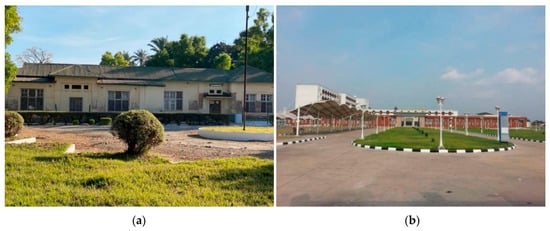
Figure 1.
Shows the external view of the hospitals; (a) Gecamine Hospital and (b) Cinquantenaire Hospital.
These two ICUs, located in areas that can be considered different in terms of noise regulatory zoning, have been investigated, given the potential influences of environmental noise on the indoor conditions of both ICUs. The proximity of the GH to industries (mineral processing plants and busy traffic roads) implies its susceptibility to environmental noise besides other noise sources. GH, built in 1925, remains the most prominent and oldest hospital in Kipushi, hence its significance in providing healthcare services. The aging building facades (Figure 1a) meet the selection criteria. The CH, built in 1954, situated in a typical residential zone flanked by several high-traffic roads, is the second-biggest hospital in the DRC, hence its importance in the provision of healthcare services and its importance as a first referral hospital. The specialized units, considerable patient traffic, employees, and the high level of activity of nursing teams at the hospital meet the selection criteria. The present study has collected perceptive data from nurses, physicians, and allied health professionals, excluding ICU patients. A cross-sectional observational study was performed in both hospitals to examine noise levels and the relationship between sound levels and health features in each ICU.
3. Methods
This study employed both subjective and objective methods. A sound level meter (SLM) was used to monitor the noise levels in the ICUs, while a survey questionnaire was used for empirical data collection regarding the noise comfort of the hospital occupants during the same period. This mixed method has been used in previous studies [35,36,37] and is observed to allow for an adequate assessment of acoustic comfort, since it allows users’ perceptions to be evaluated; hence measurements of the noise equivalent level (Leq) were performed. In contrast, the present study used questionnaires to assess the occupants’ perception of indoor noise levels in each patient’s ward. The online surveys and physical measurements were conducted in parallel for two weeks, from 5 May to 7 June 2021.
3.1. Perceptive Data on the Indoor Acoustic Environment
A survey questionnaire spanning noise annoyance and characteristics of indoor demography questions was used for the study. The target participants for this study were only hospital workers in the chosen ICUs. The investigation method avoided direct relationships between the respondent and the researcher. Furthermore, it was ensured that people could freely and independently experience the study locations. Survey participants were informed about the use of the collected response data at the outset and assured of a non-violation of any of the participants’ privacy rights.
A web link to the questionnaire was distributed via email to nurses, physicians, and allied health professionals who met the study criteria, and respondents were encouraged to distribute the link among their colleagues. The questionnaire was accessible from 24 May 2021 (07:00 a.m.) to 30 May 2021 (6:45 p.m.) in the GH, and from 02 June 2021 (07:00 a.m.) to 07 June 2021 (07:00 a.m.) in the CH. The inclusion criteria of survey participants were persons without known hearing problems, staff within the ICUs during the study period, and ICU workers with at least a year of work experience at the hospitals. Meanwhile, patients have been excluded from the study due to COVID-19-related constraints and their state of well-being. The survey participants have been identified in groups according to their supplied gender and age parameters (see Table 1). Occupants were grouped following the data provided, as per the work roles in these ICUs. The questionnaire included questions about the respondents’ length of work at the two hospital buildings to determine the dependability of the answer in terms of whether the noise level in the ICU was correctly reflected.

Table 1.
Parameters of the participants regarding the noise survey.
Survey Questionnaires
A five-item online questionnaire concerning noise was extracted from the IEQ questionnaire developed from the “encuestafacil” platform. The platform offered a choice of different languages which respondents could use to answer the questions. The questions were defined to assess the occupant’s satisfaction regarding the identifiable sound sources dominating the building and their immediate ambience. The questionnaire gave four options for several sources: traffic noise, residents’ conversations, medical devices, and industries. Particularly, occupants were asked to rate the noise pollution in the wards on a scale of 1 to 4, in which the range of 1 to 4 represented ‘very satisfied’ to ‘very dissatisfied’ respectively. The acoustic comfort questions are presented below, extracted from the main IEQ survey:
- Do you have any problems with the noise created inside the ICU?
- What proportion of noise generated inside the ward is staff-generated?
- Which is the most intrusive noise inside the ICU from the list below?
- Do you have any problems with outside noise entering the ICU room (this includes noise from adjacent rooms)?
- Which is the most intrusive noise from outside?
3.2. Physical Noise Measurements
Continuous noise level monitoring was carried out on five different days throughout 24 h in May and June 2021 in the study hospitals’ two ICUs, using the SLM. The measurements spanned daily from 7 a.m. to 7 p.m. (daytime), 7 p.m. to 11 p.m. (evening), and 11 p.m. to 7 a.m. (night) periods. In both hospitals, the total time of monitoring was a cumulative of 13 days, including weekdays and weekends: six days at GH (Kipushi) and seven days at CH (Kinshasa).
A class 2 T Tocas SL 1361 digital sound meter was used to record the noise data using the A-weighted sound pressure level scale. The SLM has a range from 30 to 130 dBA. It was calibrated before use, resulting in an uncertainty of ±1.5 dBA. The measuring stations were selected following the recommendations of the ISO 9612:2009 standard [35]. The SLM was mounted on a tripod approximately 1.5 m above floor level and 3.5 m away from sound-reflecting surfaces such as walls and doors, and the placement of the instrument did not interfere with activity in the ICU or medical apparatus as shown in Figure 2.
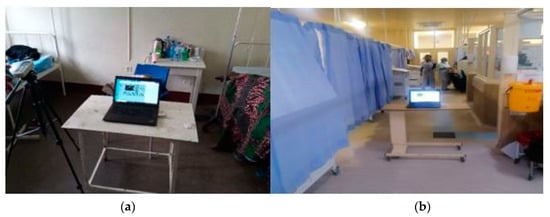
Figure 2.
Shows the interior view of the ICUs; (a) Gecamine Hospital and (b) Cinquantenaire Hospital.
The Leq makes it possible to evaluate the total noise dose received during a given time, because the risk related to noise depends on the duration as much as the sound level. A calculation is obtained in dBA over a period T. This is expressed by the notion of Level Equivalent, of which Leq is the contraction. The level LAeq (T) (for level A equivalent) is the constant noise level that would have been produced with the same energy as the noise existing during the period T considered. It expresses the average of the energy received during a period:
with:
- p(t) as the instantaneous value of the sound pressure
- P0 as the reference pressure equal to the audibility threshold (2 × 10−5 Pa)
- t as the integration time
The indicator Lden (for noise Level Day-evening-night) represents the weighted average noise level during the day, by giving a stronger weight to the noise produced in the evening (19–23 h) (+5 dBA) and during the night (23–7 h) (+10 dBA) to consider the increased sensitivity of individuals to noise pollution during these two periods. This indicator is calculated based on equivalent levels over the three base periods: day, evening, and night, to which a weighting is added according to the time of day. The Lden, therefore, expresses itself as follows:
3.3. Statistical Methods
A simple descriptive statistics and Analysis of variance (ANOVA) from the ‘XLminer analysis toolPak’ software in Microsoft Excel was employed to verify the statistical significance of acoustic parameters obtained via the online survey. The statistical evaluations have been done at a 95% confidence level (∝ = 0.05). Relevant acoustic parameters computed from the physical measurements have also been evaluated and reported.
4. Results
4.1. Perceptive Data Results
A total of 203 persons were sent the survey in GH, but only 116 responders participated, while 216 persons were sent the survey in CH, but 121 responders participated. Meanwhile, it was recorded that 50 males and 66 females participated in GH, while 43 males and 78 females participated in CH. In both cases, more females than males participated in the survey.
In Table 2, by performing ANOVA on the age groups for both GH and CH, the p = 0.84, showing statistical significance and that the mean age of the participants in the two ICUs are not the same.

Table 2.
ANOVA-Single Factor two samples of unequal variances in the ages in both ICUs.
In Table 3, the p-values = 0.95 regarding the ANOVA with the groups of noise sources for both ICUs and within the groups of satisfaction in both ICUs. There is statistical significance in the data of the paired groups, and noise sources exist in both ICUs. Furthermore, the ANOVA evaluations regarding satisfaction computed from the participants’ GH and CH responses indicate statistical significance.

Table 3.
ANOVA evaluation of the noise comfort parameters in both ICUs.
Figure 3 presents, for each point, respectively, the score of each satisfaction. It reveals that 87% and 75% of occupants in the ICU at CH and GH were dissatisfied with the acoustic environment. In comparison, 10% and 24% of patients at CH and GH respectively felt satisfied with the acoustic environment.
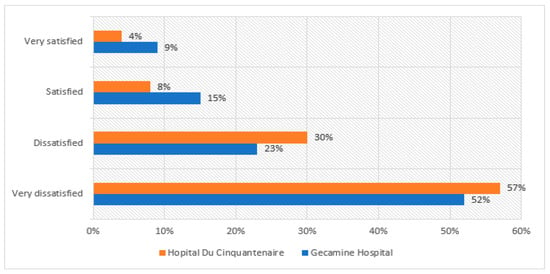
Figure 3.
Results from the questionnaire regarding satisfaction with the noise level in the patients’ wards.
Figure 4 shows that 44% and 61% of healthcare workers in CH and GH stated that most of the ICUs’ noise pollution is from the outdoors (traffic, car, and industry). The outdoor noise in CH was identified as having originated from traffic and other activities around the hospital, whereas in GH, the mineral processing plants situated 400 m away (with machines like compressors, vibrating screens, rotating breakers, and mills regularly in operation) could be considered significant noise sources contributing to high noise levels. Again, 29% and 21% of occupants’ responses stated that staff conversations in CH and GH impacted their comfort. The results show that the survey participants submitted that 27% and 19% of noise generated in ICUs was attributed to hospital equipment. Finally, occupants have not identified any noise pollution from the ventilation system since there was no mechanical ventilation system installed or in use for either ICU in both hospitals at the time of the study. Only natural ventilation was possible in the study ICUs.

Figure 4.
Subjective rating for the different noise sources generated in both intensive care units.
Table 4 presents a descriptive statistic of the noise measurements; the mean parameters indicate that noise levels exceed the acceptable indoor noise levels in ICUs during all assessed periods and days. The noise level measurements are normal distribution. Only ANOVA has been used to evaluate these three data sets of Lden.

Table 4.
Descriptive statistics of experimental noise level measurements in both ICUs for all days considering the day, evening, and night periods.
In Table 5, by performing ANOVA on noise conditions within the day, evening, and night times for each day, the p-values, 8.35 × 10−13, 2.21 × 10−14, and 0.01 × 10−14 were obtained and are all significantly less than 0.05, indicating that these noise level measurements are statistically significant and that the null hypothesis is accepted. The null hypothesis is that noise is existential at all times of day, evening, and night-time. There are high noise levels during all times of the day. The highest noise levels are computed during the day for all evaluated periods.

Table 5.
ANOVA evaluation of noise comfort parameters in both ICUs for all days considering the day, evening, and night periods.
4.2. Results of Physical Measurements
Noise levels monitoring in the GH show that the noise levels in the Gecamine ICU were a minimum and maximum of 60.5–94.6 dBA during weekdays and 33.3–94.6 dBA during the weekend, while the noise level in the evening varies from 61.9–90.0 dBA throughout the week. During the night, the minimum and maximum noise levels varied between 33.3–80.2 dBA from Monday-Friday and Sunday. The data shows 94.6 dBA peak noise levels were recorded on Thursday and Sunday between 9 a.m. and 9:30 a.m. However, the lowest noise level of 68.6 dBA was recorded in the early morning at 7 a.m. The results show that Sunday night is a quieter period in the ICU due to fewer activities by the mining company and ICU (see Figure 5). There is no significant difference in noise level between working days and weekends due to mining activities and traffic. However, the values recorded in the Gecamine ICU exceeded the day and night values recommended by the WHO’s guidelines for silence zones.
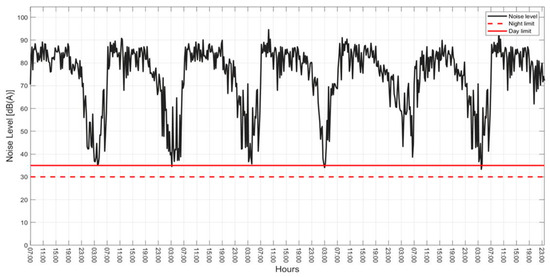
Figure 5.
shows the weekly noise level in the GH. Note: The middle line represents 35 dBA, the WHO-recommended noise level during the day, while the lowest line (dash line) represents 30 dBA, the WHO recommendation during the night. The noise produced by this equipment greatly surpasses the acceptable noise levels in the ICU.
Table 6 shows the Leq computed for the day, evening, and night-time periods on each day surveyed. The Leq during day times is not significantly different from the other times, although the night-time periods record the lowest values. The findings from the experimental monitoring in the CH showed that the noise levels in this hospital had a minimum and maximum of 31.7–79.7 dBA on Thursday and Friday. The weekday noise levels ranged from 58.8–75.5 dBA during the daytime, 57–75 dBA during the evening, and 33.9–74.8 dBA during the night. At the same time, the weekend noise level during the night ranged between 31.7–72.1 dBA and 52.3–75.6 dBA during the daytime. A peak level of 79.7 dBA was recorded on Monday morning. Figure 6 shows that the noise level on Sunday morning was significantly lower than the rest of the week.

Table 6.
Noise equivalence levels for the day, evening, and night times on each day.
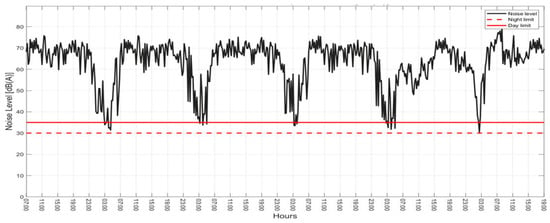
Figure 6.
Shows the weekly noise level in the CH. Note: The middle line represents 35 dBA, the WHO-recommended noise level during the day, while the lowest line (dash line) represents 30 dBA, the WHO recommendation during the night. The noise produced by this equipment greatly surpasses the acceptable noise levels in the ICU.
The weekly noise equivalent level (Leq) is estimated at 82.8 dBA with a Lden of 83.8 dBA, which is illustrated in Figure 7 above. The Leq and Lden week computed all indicate that noise levels in the ICU of GH are too high.
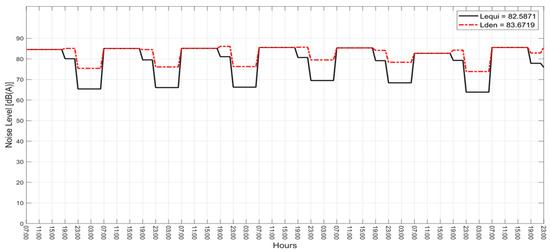
Figure 7.
The equivalent noise level (Leq) per hour measured and the day-evening-night noise level (Lden) in the GH ICU.
Figure 8 illustrates a weekly noise equivalent level (Leq) of 68.6 dBA and a Lden of 72.1 dBA. Similarly, the noise levels recorded in the ICU of CH were significantly higher than the limit recommended by the WHO standard, which mainly originate from the outdoor environment, traffic, equipment, and human conversations in the case of CH.
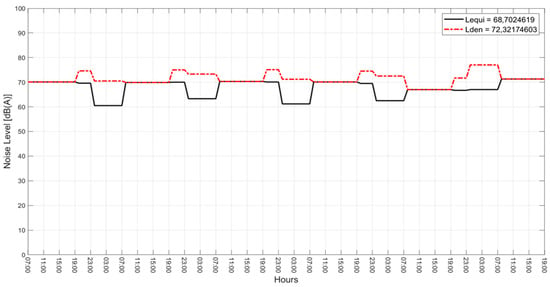
Figure 8.
The equivalent noise level (Leq) per hour measured and the day-evening-night noise level (Lden) in the CH ICU.
5. Discussion
In the ICUs, the primary noise sources were identified as unregulated conversational noise (amongst workers and patient visitors) and hospital equipment (alarms and some intruding external noises due to compromised ICU building facades). The noise source intensities were not distinguished in their scale of contribution to the overall noise levels during the measurements due to overlap and their continuous influences on the overall ambient noise, as observed in both ICUs. Meanwhile, indoor noise levels common to both ICUs may be classified as ‘thrust noise’ (from doors, machine beeps and alarms, instantaneous screams or noises, mobile phones, screeches from bed movements and hinged members) and ‘constant/quasi-constant’ noise sources (from respirators, monitoring devices, and general human conversations). It was readily observed that penetration of environmental noise into the ICUs was mainly from the nearby mineral process industry, high traffic, and unregulated commercial activities within GH’s immediate outdoors. In addition, it is noteworthy that natural ventilation is the primary ventilation system used in GH; hence, the opening of windows contributes significantly to the intrusion of outdoor noise. In the CH, the outdoor environment, particularly highway traffic, propagates sounds from neighboring religious houses, and other commercial/transport activities contribute to indoor noise. Similarly, the ventilation system in use at the CH was observed to be natural ventilation due to the inadequacy of the mechanical ventilation systems, which again allows the intrusion of outdoor noise into the ICU.
According to the results, participants expressed dissatisfaction with the acoustic comfort in both ICUs due to indoor and outdoor noise pollution. The values recorded for the day, evening, and night were much higher than the WHO’s recommended guidelines [6]. As shown, most noise generated in Gecamine Hospital is from the mineral processing plant near the hospital. In this context, we can say that occupants in this hospital are exposed to long periods of high noise pollution, which can negatively impact patients’ and healthcare workers’ health, comfort, and productivity.
The present study finds a positive correlation between indoor and outdoor noise levels in hospitals, including the influence of location. Studies regarding noise pollution sources in hospitals have revealed that traffic noise can impact hospital noise levels [38,39]. A study researched the noise level in sensitive urban areas of an industrial city in India, and the results revealed that in the patients’ rooms in the daytime, the LAeq was between 60.8–85.6 dBA and 54.0–73.8 dBA in the night-time [30], which correlates with the presence of noise pollution in hospitals as in the current study. In Taiwan, two studies assessing noise levels in ICUs reported noise levels of 77–81 dBA [40] and 68.2–64.7 dBA [32] to have exceeded the WHO limits. Another study in Brazil [41], has reported basal noise levels in pediatric ICU of 60–70 dBA, present similar outcomes to the Leq result of 60–70 dBA as in [42], all comparable to the computed LAeq levels of 82.6 dBA and 68.7 dBA in the ICUs of the current study.
In Leeds General Infirmary and St James’s University Hospital, the authors discovered that the noise levels in one unit were 36.6–80 dBA and 40.6–86.2 dBA in another [43], comparable to the findings of this study. Meanwhile, one study by [11] reported much lower values than those of the current study – minimum and maximum Leq in the ICU of 45.5 dBA and 59.2 dBA respectively. However, the values reported for these studies still exceed the WHO noise limit. Since hospital workers in GH can be exposed to several hours of high noise levels, such as levels of city-traffic noise (80–85 dB) in the ICU [21] or approximating noise levels of occupational limits by the National Institute for Occupational Safety and Health (85 dBA as 8 h time-weighted average [TWA]), there is a high risk of associated health challenges. Furthermore, the proximity of GH to the mineral processing plants suggests significant risks to the health and life quality of the noise-exposed occupants due to intruding high levels of industrial noise, directly or indirectly for the noise-exposed industry workers [19].
Furthermore, the Lden calculation has shown that the noise level in the GH is higher than in the CH. Since the GH’s location is exposed to higher levels of ambient noise (from industries and heavy road traffic), including its primary dependence on natural ventilation, the chances are higher that outdoor noise significantly impacts the indoor noise conditions as compared to the CH, which is situated in a residential zone. Meanwhile, we observe similarities of influence from existential primary noise sources to both hospitals: road traffic, commercial activities (ranging from kiosks to other small/mobile businesses), markets, and churches. Notably, there are no noise insulation features in either of the study hospitals that may help mitigate or prevent the intrusion of outdoor noise or absorption of indoor noise, especially for the ICUs and patient wards.
The current study assessment of noise sources contributing to levels of the ICU of CH are akin to some noise sources discussed by [44] in the assessment of noise in two Edinburgh ICUs, where the author reported that road traffic, medical equipment, and general activity including conversations as significant noise sources in the hospital. Similarly, studies have revealed that medical apparatus, bells, conversations among staff, visitors, and caregiving activities are relevant noise sources in hospitals [44,45], alluding to the findings of the present study that these same noise sources impacted the noise levels in both ICUs. Regulation of thrust noise, including conversational noise in ICUs, may also be mitigated through behavioral interventions [24], given that a substantial part of these ‘thrust noises’ are associated with human conduct and observed during the present study’s physical measurements. Similarly, the findings by [41] reporting that the time of day exerts the highest level of influence regarding noise levels in the ICU is corroborated by the computed Leq in both CH and GH for the present (see Table 6). All the Leq during daytime noise levels exceeded the evening and night noise levels, except for one of the days.
The data in this study have shown that the noise levels recorded in the ICUs exceed the WHO recommendations, corroborating the several findings and conclusions of many ICU noise studies [25,38,42]. The reported noise levels suggest a high risk to health and well-being aside from physiological [46] and psychological impacts, including the possibility of negative impacts on the quality of life in noise-exposed persons.
5.1. Proposed Noise Mitigation Strategies for the Studied Hospitals
The noise assessment results suggest the need to deploy mitigation strategies regarding the hazardous indoor noise levels in both ICUs, which can be executed following the main approaches to implement managerial, acoustical, and engineering solutions discussed below.
- Noise abatement and control measures at the noise sources
- The immediate outdoor and building facade measures
- The indoor or internal mitigation measures
The first approach (1 and 2 above) is classified as external, while the second approach concerns indoor noise reduction measures.
5.2. Noise Abatement and Control Measures at the Noise Sources
In the outdoor areas of the GH and CH, the exposure to industrial noise and traffic noise impacts significantly due to their proximity, dependence on natural ventilation (frequently opened windows), and non-acoustic building facades. Considering the inherent challenges and inadequate compliance with global building standards in many developing tropical countries, including the DRC, many buildings may lack functional and performance considerations for indoor environmental quality, including acoustic comfort. Furthermore, for this and similar tropical countries, it is recommended that any implemented noise mitigation solution should consider a reasonable trade-off regarding the indoor climate conditions (thermal comfort and indoor air quality), which can impact the comfort, safety, and well-being of occupants significantly.
Hence, abating noise at the source is a practical approach regarding the study ICUs while complementing outdoor noise control measures with indoor measures to deploy a holistic intervention. The following noise mitigation solutions are recommended regarding the study ICUs:
- Installing primary barriers beside the road with a possibility of reducing up to 5 to 15 dBA [47] of generated noise from road traffic and the industries flanking the dividing road between hospitals and industry. Planting trees and other plants to ensure an absorptive vegetable cover near these roads can also help in noise mitigation.
- There is a need to manage the ambient traffic by regulating the vehicle speeds on the nearby roads, since an increase in vehicle speed (higher levels of engine noise and noise from tires) can increase the vehicle noise. A speed limit not exceeding 30–40 km/h is recommended. Given that there are industries in proximity to these ICUs, it is understandable to consider the tendency of traffic from a significant number of heavy trucks and vehicle traffic, hence a good to introduce speed limits and changes to road design, like an acoustic improvement to the road surfaces that are near the ICUs and industry.
5.3. Immediate Outdoor and Building Facade Measures
Two practical measures are recommended. The first is fencing the immediate areas of the ICUs and increasing the green surface area, including planting trees to mitigate the propagation of ambient noise within the ICU environment and the propagated sounds from neighboring industries and road traffic. The leveled topography and landscape of the study ICUs favor the recommended measures. Secondly, acoustic layers on these ICUs’ external building facades and walls. The need to ensure the building envelope’s thermal permeability in considering the buildings’ indoor climate in a tropical climate is significant in implementing a trade-off while ensuring acoustic facades (wall insulations and thickness).
Again, any implemented acoustic solution or measure must consider trade-offs regarding hygiene requirements and indoor climate. The outdoor environment influences the noise levels in both ICUs, location, and building components, but the disparity in the noise levels recorded for the ICU of the GH further affirms the impact of its co-location with a noisy industrial zone, in contrast to the ICU of the CH, which is situated in a residential area. The windows used in the ICUs are not double-glazed or soundproof, which is typical for window installations in tropical climate regions. There is a need to replace the current windows of these ICU buildings with soundproof windows and doors, which can also limit the intrusion of external noise.
5.4. The Indoor or Internal Mitigation Measures
Figure 9 shows the use of an external sound insulation material on the building facade and the reduction of floor-to-ceiling height to achieve less reverberation and echo in the ICU indoor space. External noise insulation on the building facades is suggested as a more practical solution than internal rework of the building walls, which may negatively impact building thermal properties, and require critical downtime of healthcare services during the installation, in addition to the possibility of higher costs. In both GH and CH, noise sources include nursing-related conversations, medical machines, and outdoor pollution. Some changes to the internal ICU walls and ceilings are recommended to reduce these noise sources. The existing walls are not designed with acoustic considerations, hence the need to introduce absorption materials in walls and ceilings. The ceilings already have heights exceeding 6 m from the floor level; therefore, a reduced floor-to-ceiling height (4 m) will minimize the reverberation volume in space, including the obstruction of reflected sound and internal propagation. For all materials used, cleanability and hygiene factors are critical considerations. Again, using acoustic absorbent and washable wall panels can increase the absorption of noise possibly originating from the nurses’ station and corridors, reducing the overall noise level in the space, is an average of 5 dBA [48]. Moreover, reducing the ceiling height in the corridor will decrease the noise attenuation in the corridor areas.
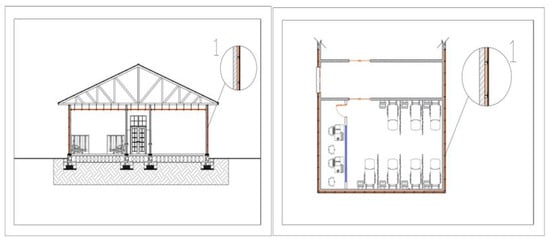
Figure 9.
A sectioned front and plan view representation of the ICU building, showing external noise mitigation measures on the building wall.
Figure 10 offers a pictorial representation of some proposed solutions for the corridors and ICU rooms—mainly decorative acoustic materials, acoustic ceilings, acoustic doors, reduced and rearranged hallway seats, and installed wall paintings. Meanwhile, noise-absorbent partitioning walls will be installed in the ICU rooms, and equipment will be relocated from direct mounting walls and silicone rubber mounts and wheels.
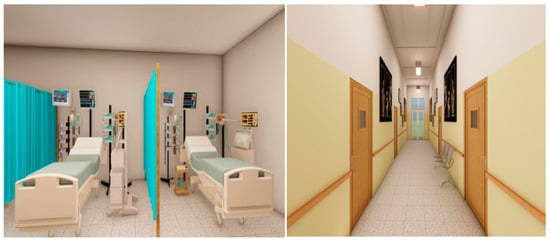
Figure 10.
A pictorial representation of the ICU corridor rooms with some solutions implemented.
Maintaining specific light intensities in rooms to help regulate patients’ circadian rhythms, installing sound-absorbing panels to reduce environmental noise, using antimicrobial building materials to reduce nosocomial infections, and installing high-efficiency particulate air filters to ensure air quality, could all be considered to improve noise levels in the patient room. Regarding noise pollution from different machines like bedside monitors, a hemofiltration machine, installing sound-absorbing panels or trellises, and using mobile equipment with rubber wheels (silicone material) can reduce the amount of noise caused by friction between the wheels and the ICU flooring [49]. The goal is to reduce mechanical vibration associated with the installation and position of the powered equipment, since vibration and noise often co-locate. Another practical decision is to relocate some medical equipment away from walls, which can dampen noises caused by sound reflection [50]. It is recommended to use some easy-to-clean, acoustic-absorbent decorative objects, fulfilling aesthetic, therapeutic, and noise-reducing purposes along the hallway and some ICU rooms. All these can help to reduce the internal noise levels in the ICUs.
5.5. Limitations of the Study
- This study has not distinguished the specific impact of each identifiable contributing noise source.
- A more robust evaluation of noise parameters and impact may be done in future works, as during this survey, the IEQ questionnaire was used to evaluate other IEQ parameters, and noise data were extracted from a wider group.
- A future study for this region would pay attention to the categorized impact of noise on the healthcare workers and hospital occupants concerning annoyance/irritations, short- and long-term health effects vis-à-vis the challenges associated with occupational exposure hours, stress, and performance variables.
- A control experiment to evaluate the effects of ambient noise between two groups of healthcare workers may be more revealing of the impact, although the current study has confirmed the presence of high noise levels beyond the WHO limits (35 dBA).
- In order to adequately evaluate the difference in the acoustic porosity of these ICUs for more adapted mitigation measures, it is recommended that a pre-study noise audit of the hospital buildings and equipment be performed, given that many hospitals in developing tropical countries are somewhat in deficit regarding compliance with global standards, separate from the peculiarities of the tropical climate, environmental, and socio-cultural factors.
6. Conclusions
The noise levels recorded in the study ICUs do not meet the WHO requirements for hospitals. These findings suggest that the noise levels in the ICUs of the GH and CH are significantly inadequate for the comfort and health of noise-exposed occupants. Hospital workers and patients in both hospitals are thus prone to long-term exposure to high noise levels, which can negatively impact the recovery patient, causing rest disturbance, annoyance, and the risk of cardiovascular problems.
There is no doubt that many hospital workers experience stress and rigorous schedules, which can become more detrimental to physiological and psychological well-being and hearing loss in case of long-time exposure to high noise levels. Other associated demerits are the possibility of increased rates of medical error, auditory difficulty, limited intelligibility, and high stress levels. The noise levels recorded in the current study suggest environmental noise can significantly impact indoor noise, as in the case of the Gecamine ICU (82.6 dBA), which significantly exceeded the noise levels of the Cinquantenaire ICU (68.7 dBA). The factors of building location and time of the day are observed to affect indoor noise levels in ICUs for this current study.
Again, it is highly recommended that mechanical ventilation systems be installed in the studied hospitals, especially for these ICUs, which currently depend on natural ventilation, in turn preventing considerable outdoor noise intrusion. While some suggested noise mitigation measures address noise sources, a holistic approach to noise mitigation measures is recommended, including the choice of noise-sensible zones for siting hospital buildings while still considering other important factors regarding health care services.
It is noteworthy to consider the use of suitable policies that can help in the compliance with well-adapted and sustainable noise regulations for both indoor and outdoor environments in the DRC and similar developing tropical countries, where several studies have reported that gaps currently exist regarding scientific data, policy, practice, and implementation of IEQ regulations. Finally, there is a need for more scientific studies, social awareness, and community sensitization to the associated risk of exposure to high noise levels. In general, a positive change in people’s behavior and culture may help lower the anthropogenic contributions to noise in indoor spaces and outdoor environments, should considerable efforts be made toward adequate sensitization and awareness regarding noise.
Author Contributions
Conceptualization, J.-P.K.B.N. and J.O.O.; methodology, J.-P.K.B.N. and J.O.O.; formal Analysis, J.-P.K.B.N. and J.O.O.; investigation, J.-P.K.B.N.; resources, J.-P.K.B.N., J.O.O. and M.G.d.S.; data curation J.-P.K.B.N. and J.O.O.; writing—original draft preparation, J.-P.K.B.N. and J.O.O.; writing—review and editing, J.-P.K.B.N., J.O.O. and M.G.d.S.; supervision, M.G.d.S. and N.A.V.S. All authors have read and agreed to the published version of the manuscript.
Funding
The first author has a PhD research grant from 3SqAir Interreg Sudoe Project. The second author has a PhD research grant from the Portuguese Foundation for Science and Technology (FCT), Portugal. REF: UI/BD/152067/2021.
Data Availability Statement
The data presented in this study are available on request from the corresponding author.
Acknowledgments
The project supervision by the University of Coimbra, ADAI, and the funding support of the Portuguese Foundation for Science and Technology (FCT) is gratefully acknowledged. The authors would like to thank the Hospital’s administration for facilitating the monitoring program. Special thanks are extended to Université Nouveaux Horizons for the provision of the hospital contact, testing lab, and transport. The authors wish to acknowledge Jan Karlshoj, Denmark Technical University, for his support. The authors wish to acknowledge LAETA - Laboratório Associado de Energia, Transportes e Aeronáutica.
Conflicts of Interest
The authors declare no conflict of interest.
References
- Morrison, W.E.; Haas, E.C.; Shaffner, D.H.; Garrett, E.S.; Fackler, J.C. Noise, stress, and annoyance in a pediatric intensive care unit. Crit. Care Med. 2003, 31, 113–119. [Google Scholar] [CrossRef] [PubMed]
- Bliefnick, J.M.; Ryherd, E.E.; Jackson, R. Evaluating hospital soundscapes to improve patient experience. J. Acoust. Soc. Am. 2019, 145, 1117–1128. [Google Scholar] [CrossRef] [PubMed]
- Delaney, L.J.; Currie, M.J.; Huang, H.-C.C.; Lopez, V.; Litton, E.; Van Haren, F. The nocturnal acoustical intensity of the intensive care environment: An observational study. J. Intensiv. Care 2017, 5, 41. [Google Scholar] [CrossRef]
- Berg, A.L. Monitoring Noise Levels in a Tertiary Neonatal Intensive Care Unit. Contemp. Issues Commun. Sci. Disord. 2010, 37, 69–72. [Google Scholar] [CrossRef]
- Environmental Protection Agency. Information on Levels of Environmental Noise Requisite to Protect; NPC Online Library: Montpelier, VT, USA, 1974; pp. 1–76. [Google Scholar]
- Schwela, D.H. The new World Health Organization guidelines for community noise. Noise Control Eng. J. 2001, 49, 193. [Google Scholar] [CrossRef]
- WHO. On Hand Hygiene in Health Care First Global Patient Safety Challenge Clean Care Is Safer Care. 2009. Available online: https://www.who.int/publications/i/item/9789241597906. (accessed on 1 December 2022).
- Van Reenen, C.A. A case study investigation of the indoor environmental noise in four urban South African hospitals. Proc. Mtgs. Acoust. 2015, 25, 015002. [Google Scholar] [CrossRef]
- Khademi, G.; Imani, B. Noise pollution in intensive care units: A systematic review article. Rev. Clin. Med. 2015, 2, 58–64. [Google Scholar] [CrossRef]
- Bhave, P.; Sayed, K. Noise pollution in sensitive zone and its effects: A review. Int. Adv. Res. J. Sci. Eng. Technol. 2015, 2, 78–83. [Google Scholar] [CrossRef]
- Bayo, M.V.; García, A.M.; Garcia, A. Noise Levels in an Urban Hospital and Workers’ Subjective Responses. Arch. Environ. Health Int. J. 1995, 50, 247–251. [Google Scholar] [CrossRef]
- Cmiel, C.A.; Karr, D.; Gasser, D.; Oliphant, L.; Neveau, A.J. Noise Control: A Nursing Team’s Approach to Sleep Promotion: Respecting the silence creates a healthier environment for your patients. AJN Am. J. Nurs. 2004, 104, 40–48. [Google Scholar] [CrossRef]
- Basner, M.; Babisch, W.; Davis, A.; Brink, M.; Clark, C.; Janssen, S.; Stansfeld, S. Auditory and non-auditory effects of noise on health. Lancet 2013, 383, 1325–1332. [Google Scholar] [CrossRef] [PubMed]
- Hunashal, R.B.; Patil, Y.B. Assessment of Noise Pollution Indices in the City of Kolhapur, India. Procedia-Soc. Behav. Sci. 2012, 37, 448–457. [Google Scholar] [CrossRef]
- Xie, H.; Kang, J.; Mills, G.H. Clinical review: The impact of noise on patients’ sleep and the effectiveness of noise reduction strategies in intensive care units. Crit. Care 2009, 13, 208. [Google Scholar] [CrossRef] [PubMed]
- World Health Organization. Burden of Disease from Environmental Noise Quantification of Healthy Life Years Lost in Europe. WHO Regional Office for Europe: Copenhagen, Denmark, 2011. [Google Scholar]
- Flynn, E.A.; Barker, K.N.; Gibson, J.T.; Pearson, R.E.; Berger, B.A.; Smith, L.A. Impact of interruptions and distractions on dispensing errors in an ambulatory care pharmacy. Am. J. Health Pharm. 1999, 56, 1319–1325. [Google Scholar] [CrossRef]
- Lawson, S.M.; Masterson, E.A. Hearing Loss Among Health Care and Social Assistance Workers: A NIOSH Study. Hear. J. 2019, 72, 12–13. [Google Scholar] [CrossRef]
- Themann, C.L.; Masterson, E.A. Occupational noise exposure: A review of its effects, epidemiology, and impact with recommendations for reducing its burden. J. Acoust. Soc. Am. 2019, 146, 3879–3905. [Google Scholar] [CrossRef]
- Plack, C.J.; Barker, D.J.P.; Prendergast, G. Perceptual Consequences of “Hidden” Hearing Loss. Trends Hear. 2014, 18, 2331216514550621. [Google Scholar] [CrossRef]
- Ding, M.T.; Yan, A. What is noise-induced hearing loss? Br. J. Hosp. Med. 2019, 80, 525–529. [Google Scholar] [CrossRef]
- Blomkvist, V.; A Eriksen, C.; Theorell, T.; Ulrich, R.; Rasmanis, G. Acoustics and psychosocial environment in intensive coronary care. Occup. Environ. Med. 2005, 62, e1. [Google Scholar] [CrossRef]
- van Hoof, J.; Kort, H.; Duijnstee, M.; Rutten, P.; Hensen, J. The indoor environment and the integrated design of homes for older people with dementia. Build. Environ. 2010, 45, 1244–1261. [Google Scholar] [CrossRef]
- Schmidt, N.; Gerber, S.M.; Zante, B.; Gawliczek, T.; Chesham, A.; Gutbrod, K.; Müri, R.M.; Nef, T.; Schefold, J.C.; Jeitziner, M.-M. Effects of intensive care unit ambient sounds on healthcare professionals: Results of an online survey and noise exposure in an experimental setting. Intensiv. Care Med. Exp. 2020, 8, 34. [Google Scholar] [CrossRef] [PubMed]
- Andrade, E.D.L.; Silva, D.C.D.C.E.; de Lima, E.A.; de Oliveira, R.A.; Zannin, P.H.T.; Martins, A.C.G. Environmental noise in hospitals: A systematic review. Environ. Sci. Pollut. Res. 2021, 28, 19629–19642. [Google Scholar] [CrossRef] [PubMed]
- Khan, J.; Ketzel, M.; Kakosimos, K.; Sørensen, M.; Jensen, S.S. Road traffic air and noise pollution exposure assessment—A review of tools and techniques. Sci. Total. Environ. 2018, 634, 661–676. [Google Scholar] [CrossRef]
- Wallis, R.; Harris, E.; Lee, H.; Davies, W.; Astin, F. Environmental Noise Levels in Hospital Settings: A Rapid Review of Measurement Techniques and Implementation in Hospital Settings. Noise Health 2020, 21, 200–216. [Google Scholar]
- Okokon, E.O.; Taimisto, P.; Turunen, A.W.; Amoda, O.A.; Fasasi, A.E.; Adeyemi, L.G.; Juutilainen, J.; Lanki, T. Particulate air pollution and noise: Assessing commuter exposure in Africa’s most populous city. J. Transp. Health 2018, 9, 150–160. [Google Scholar] [CrossRef]
- Sieber, C.; Ragettli, M.S.; Brink, M.; Olaniyan, T.; Baatjies, R.; Saucy, A.; Vienneau, D.; Probst-Hensch, N.; Dalvie, M.A.; Röösli, M. Comparison of sensitivity and annoyance to road traffic and community noise between a South African and a Swiss population sample. Environ. Pollut. 2018, 241, 1056–1062. [Google Scholar] [CrossRef]
- Banerjee, D.; Chakraborty, S.; Bhattacharyya, S.; Gangopadhyay, A. Evaluation and analysis of road traffic noise in asansol, West Bengal. J. Inst. Eng. Environ. Eng. Div. 2008, 89, 9–16. [Google Scholar]
- Hsu, T.; Ryherd, E.; Waye, K.P.; Ackerman, J. Noise Pollution in Hospitals: Impact on Patients. JCOM 2012, 19, 301–309. [Google Scholar]
- A Alduais, S.; Salama, K.F. Assessment Of Ambient-Noise Exposure Among Female Nurses In Surgical Cardiac Intensive Care Unit. J. Multidiscip. Health 2019, 12, 1007–1011. [Google Scholar] [CrossRef]
- Vanwelde, B.; Calcut, T.; Young, H. Environmental and Social Impact Assessment in Countries with Limited Regulatory Frameworks: Lessons from the Democratic Republic of the Congo. 2013. Available online: www.iaia.org (accessed on 1 December 2022).
- Andreucci, M.B.; Marvuglia, A.; Baltov, M.; Hansen, P. Future City 15 Rethinking Sustainability Towards a Regenerative Economy. Available online: http://www.springer.com/series/8178 (accessed on 1 December 2022).
- Castro, F.L.; Iarossi, S.; Brambilla, G.; Mariconte, R.; Diano, M.; Bruzzaniti, V.; Strigari, L.; Raffaele, G.; Giliberti, C. Surveys on Noise in Some Hospital Wards and Self-Reported Reactions from Staff: A Case Study. Buildings 2022, 12, 2077. [Google Scholar] [CrossRef]
- Juang, D.F.; Lee, C.; Yang, T.; Chang, M.C. A BS T RA C T: Noise pollution and its effects on medical care workers and patients in hospitals. Int. J. Environ. Sci. Technol. 2010, 7, 705–716. [Google Scholar] [CrossRef]
- Wiese, C.H.; Wang, L.M. LV-11-C031: Measured Levels of Hospital Noise before, during, and after Renovation of a Hospital Wing, and a Survey of Resulting Patient Perception. 2011. Available online: https://digitalcommons.unl.edu/archengfacpub/44 (accessed on 1 December 2022).
- Montes-González, D.; Barrigón-Morillas, J.M.; Escobar, V.G.; Vílchez-Gómez, R.; Rey-Gozalo, G.; Atanasio-Moraga, P.; Méndez-Sierra, J.A. Environmental Noise around Hospital Areas: A Case Study. Environments 2019, 6, 41. [Google Scholar] [CrossRef]
- Khaiwal, R.; Singh, T.; Tripathy, J.P.; Mor, S.; Munjal, S.; Patro, B.; Panda, N. Assessment of noise pollution in and around a sensitive zone in North India and its non-auditory impacts. Sci. Total. Environ. 2016, 566–567, 981–987. [Google Scholar] [CrossRef]
- Hsu, S.; Ko, W.; Liao, W.; Huang, S.; Chen, R.J.; Li, C.; Hwang, S. Associations of exposure to noise with physiological and psychological outcomes among post-cardiac surgery patients in ICUs. Clinics 2010, 65, 985–989. [Google Scholar] [CrossRef] [PubMed]
- Carvalho, W.B.; Pedreira, M.L.; Aguiar, M.A. Noise level in a pediatric intensive care unit. J. Pediatr. 2005, 81, 495–498. [Google Scholar] [CrossRef]
- Busch-Vishniac, I.J.; West, J.E.; Barnhill, C.; Hunter, T.; Orellana, D.; Chivukula, R. Noise levels in Johns Hopkins Hospital. J. Acoust. Soc. Am. 2005, 118, 3629–3645. [Google Scholar] [CrossRef]
- Padmakumar, A.D.; Bhasin, V.; Wenham, T.N.; Bodenham, A.R. Evaluation of Noise Levels in Intensive Care Units in Two Large Teaching Hospitals—A Prospective Observational Study. J. Intensiv. Care Soc. 2013, 14, 205–210. [Google Scholar] [CrossRef]
- MacKenzie, D.; Galbrun, L. Noise levels and noise sources in acute care hospital wards. Build. Serv. Eng. Res. Technol. 2007, 28, 117–131. [Google Scholar] [CrossRef]
- Konkani, A.; Oakley, B. Noise in hospital intensive care units—A critical review of a critical topic. J. Crit. Care 2012, 27, 522.e1–522.e9. [Google Scholar] [CrossRef]
- Bolaji, B.O.; Olanipekun, M.U.; Adekunle, A.A.; Adeleke, A.E. An analysis of noise and its environmental burden on the example of Nigerian manufacturing companies. J. Clean. Prod. 2018, 172, 1800–1806. [Google Scholar] [CrossRef]
- Glasson, J.; Therivel, R.; Chadwick, A. Methods of Environmental Impact Assessment, 2nd ed.; The Natural and Built Environment Series; Taylor and Francis: London, UK, 2000. [Google Scholar]
- MacLeod, M.; Dunn, J.; Busch-Vishniac, I.J.; West, J.E.; Reedy, A. Quieting Weinberg 5C: A case study in hospital noise control. J. Acoust. Soc. Am. 2007, 121, 3501–3508. [Google Scholar] [CrossRef] [PubMed]
- Smirnova, O.M.; de Navascués, I.M.P.; Mikhailevskii, V.R.; Kolosov, O.I.; Skolota, N.S. Sound-Absorbing Composites with Rubber Crumb from Used Tires. Appl. Sci. 2021, 11, 7347. [Google Scholar] [CrossRef]
- Peng, L.; Zhao, P.; Cheng, H.; He, Q.; Du, L. Improved low-frequency sound absorption of porous silicone rubber resonance sheet with periodic cavities. J. Low Freq. Noise Vib. Act. Control 2022, 41, 1151–1159. [Google Scholar] [CrossRef]
Disclaimer/Publisher’s Note: The statements, opinions and data contained in all publications are solely those of the individual author(s) and contributor(s) and not of MDPI and/or the editor(s). MDPI and/or the editor(s) disclaim responsibility for any injury to people or property resulting from any ideas, methods, instructions or products referred to in the content. |
© 2023 by the authors. Licensee MDPI, Basel, Switzerland. This article is an open access article distributed under the terms and conditions of the Creative Commons Attribution (CC BY) license (https://creativecommons.org/licenses/by/4.0/).